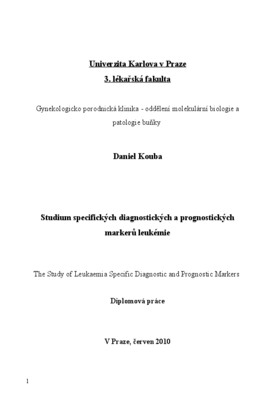Studium specifických diagnostických a prognostických markerů u leukémie
The Study of Leukaemia Specific Diagnostic and Prognostic Markers
diplomová práce (OBHÁJENO)

Zobrazit/
Trvalý odkaz
http://hdl.handle.net/20.500.11956/29471Identifikátory
SIS: 63201
Kolekce
- Kvalifikační práce [3155]
Autor
Vedoucí práce
Fakulta / součást
3. lékařská fakulta
Obor
-
Katedra / ústav / klinika
Gynekologicko porodnická klinika - oddělení molekulární biologie a patologie buňky
Datum obhajoby
24. 6. 2010
Nakladatel
Univerzita Karlova, 3. lékařská fakultaJazyk
Čeština
Známka
Výborně
Ve své práci jsem se zaměřil na výzkum specifických diagnostických a prognostických markerů akutní myeloidní, chronické myeloidní a chronické lymfocytární leukémie. U AML představují v současnosti hlavní prognostický marker cytogenetické abnormality. Pacienty, které nelze na základě cytogenetického vyšetření spolehlivě zařadit do prognostické skupiny, lze stratifikovat pomocí průkazu specifických genových mutací, nebo průkazem zvýšené úrovně exprese některých genů. Nejvýznamnější a také nejčastěji nacházený prognostický marker u AML představuje mutace FLT3- LM. Produkt tohoto genu je zároveň teoretickým cílem pro terapii. Hlavní diagnostický marker u CML je gen bcr-abl, který ve většině případů vzniká při t(22,9). Objev inhibitorů tyrozinkinázy bcr-abl zásadně změnil přístup k léčbě i prognózu nemocných. U CLL umožňuje vyšetření mutačního stavu genů pro těžké řetězce imunoglobulinů rozdělit nemocné do dvou skupin s odlišnou patogenezí i očekávaným průběhem. Další prognostické údaje poskytuje cytogenetické vyšetření a stanovení úrovně exprese CD38 a ZAP-70.
In my theses I concentrated on examination of specific prognostic markers of acute myeloid leukemia, chronic myeloid leukemia and chronic lymphocytic leukemia. Today by AML diagnose the cytogenetic abnormalities are considered the main prognostic marker. Patients, whose prognostic group it is not possible to identify with certainty just on the bases of cytogenetic examination, can be stratified by proving the presence of specific gene mutations or high expression levels of of some genes. The most important and most frequently identified prognostic marker by AML is mutation of FLT3-LM. Protein coded by this gene is also a hypothetical aim of the treatment. The crucial diagnostic marker of CML is the gene bcr-abl, which, in most of the cases, is a product of t(22,9). The discovery of inhibitors of tyroxine kinase bcr-abl brought about a substantial change into the aproach of the treatment as well as into the prognose of the ill. Through examination of immunoglobulin heavy-chain gene mutation status it is possible to divide patients with CLL into two subgroups with different pathogenesis and advancement of the illness. Other prognostic data can be acquired from cytogenetic examination and from essay of the level of CD38 and ZAP-70.
